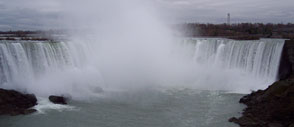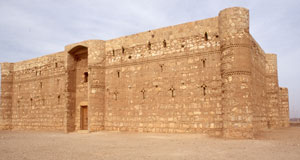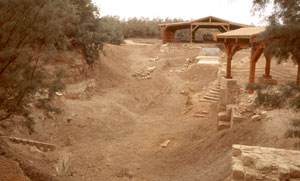
| Amman | Desert Castles | Dead Sea |
Are you nuts? That was the general response for most people when I told them I was planning on visiting the Middle East for a vacation. I've been putting off visiting the Middle East for many years waiting for some form of stability in the area before visiting but I'm starting to think I'll be long dead and buried before that happens. Terrorism is too random to worry about too much anyway, I've been to the World Trade Center and used the trains in Madrid and London before terrorism incidents and Bali, Tanzania and Peru after the fact. If you really want something to worry about remember more people are killed every year in traffic accidents. The most dangerous thing most people do in their lives is drive, anything you do that's less dangerous than driving a car is probably an acceptable risk. More people have been killed in traffic accidents in Israel than in all of Israel's wars combined. Plus with war and civil unrest in neighbouring countries that should make for fewer travellers in Jordan. Actually if we hadn't already had money spend on our Tanzanian holiday in 1998 (airline tickets plus 25% of our safari cost) we would have went to Egypt after the terrorist incident at Luxor. Fewer crowds and lower prices. More later on the advantage of disaster travel.
My wife had a problem getting her boss to sign her vacation form once she found out we were visiting Jordan. My boss? Born in Vietnam, visited Luxor in 1998, in Kuwait in 2001 for a conference just before the American invasion of Iraq, Hanoi during the SARS scare in 2002 strangely she did not have a problem signing my request for vacation.

One of the disadvantages of living in a small city is trying to get good connections to far-flung regions of the world. Charter flights to Florida or Cuba no problems otherwise overnights or very long days on airplanes. All flights from St. John's to London arrived too late to get any connecting flights to Jordan so we would have to overnight in an expensive city, been there done that. Instead we decided for a cheaper option but longer travel time. First a flight to Toronto with an 8 hour layover. We rented a car and visited Niagara Falls. Then an overnight flight to Frankfurt with a 13 hour layover. Train into the city for a day of sightseeing. Evening flight to Amman which arrived at around 2 in the morning. Many people spend the rest of the night in the airport and wait for the morning before venturing into Amman.
|
Amman is the capital and largest city in Jordan and even though its been inhabited since the Neolithic era about 9000 years ago, its really a modern city with little ancient grandeur but since this is your entry point into Jordan there are some sites in the city and it makes a good base of operations for visiting nearby sites. The growth in Amman is very much influenced by events beyond its borders, floods of Palestinians refugees in 1948, 1967, and 1991 and Lebanese civil war in 1975 caused influxes of people and money. Amman had about 10,000 people in 1945, today its around 2 million in the city and its sprawling suburbs. Amman is a very Western city and the hospitality of its citizens seems
genuine.
The area might have been inhabited for about 9000 years but you have to visit Cairo or Damascus to see a grand Islamic city of antiquity, Amman's main ancient sites can easily be visited in half a day. Amman is a city build on hills, distance might look close on a map but roads often wind around the hills. The sites are downtown where you will meet the only real hazard in Jordan, trying to cross the street. We arrived in Amman on the last day of Ramadan and the downtown area was crowded with shoppers preparing for the Eid al-Fitr which marks the end of fasting. The Roman Theatre is the main tourist site downtown, if you look lost locals will point you in the direction. Its cut into the hillside and seats about 6,000 people with wonderful acoustics. A Roman forum, a smaller theatre called Odean and several small museums are nearby. Guides are available for a small fee. We meet Steve here who was also our guide the following day. You will run into many taxi drivers who will want to act as a guide, while I'm sure most of them are genuine its probably best to get your hotel to make arrangements. Steve was an excellent guide with great stories. From the Theatre you can see pillars of the Temple of Hercules on top of Jebel al-Qal'a (Citadel Hill). This area is the other main ancient area of Amman. The site contains not only the Temple of Hercules but the National Archaeological Museum, a ruined Byzantine church, and the Umayyad Palace complex which dates from around 720. The Hercules temple stands at the head of a staircase which originally started at the Roman Forum. The National museum has a huge collection but the museum itself is small and badly organized, too bad considering the collection dates back to the Neolithic period which included the earliest human figure ever discovered over 8000 years old. Some of the Dead Sea scrolls are here as are materials from the Bronze Age, Iron Age, Hellenistic, Roman, Byzantine, Nabatean, and Islamic. A new larger more modern museum is badly needed and supposedly the Japanese government is investing money in building a new museum and restoring the monumental staircase that connected the Roman Forum to the Temple of Hercules in the past. Although it is suppose to be finished in 2005 it looked far from finished when we were there in late 2004. Downtown is the life of Amman with bazaars, souqs and cheap hotels and the heart of downtown is probably the lively King Husseini Mosque. Although the site of a mosque since 640 and before that a Byzantine church the entire site was razed to the ground in 1932 to build the present mosque. Near the mosques is a Roman Nymphaeum or public fountain still being restored. Desert Castles
East of Amman is the Eastern Desert which extends to the Iraqi border and is the harshest and less populated part of the country. There are dozens of archaeological sites here, palaces, forts, bathhouses, inns and farmhouses which collective were called the Desert Castles even thou not many sites are actually castles but the term stuck. When many were originally builted over 1200 years ago the area was semi-fertile with many oasis but changes in climate and man induced changes has made the area desert. With so few people living here there is a lack of local transportation, most tourists see the desert castles as part of a tour but the lack of local transportation will make a tour here one of the more expensive in the country about 40 JD a car load, your hotel can make arrangements. Most tours are done as a circular route from Amman with Azraq as the furthest point. Qasr Hraneh is the place that probably gave the east desert structures the name "Desert Castles" since it looks very much like a defensive building with rounded corner towers, arrow slits and a single well defendable entrance. The corner towers are actually solid rock and the arrow slits were more likely used for lighting purposes unless the defenders stood 3 metres tall with triple length arms. The generally accepted use for this building was an inn since it is close to several trade routes. If you are coming from Amman this is probably your first "desert castle" and you would have passed by the training facility used to train the new Iraq police force at the point were the highway widens for use as an
emergency runway for the Queen Alia Airport.
Continuing from Qasr Hraneh the next site is the World Heritage site of Qusayr Amra, a squat shape building resting in the Wadi Butm, a former bathhouse probably used by the caliph. There is nothing special about the building, inside is where the real treasure is located with frescoes covering almost the entire inside of the building. Let your eyes adjust to the darkness for a few minutes when you first enter the bath house. The information board in the
interpretation centre assures visitors that the frescoes "Do not portray scenes of unbridled loose-living or carryings-on". Sure, whatever you say. Considering that the bathhouse was build in the same period as when Islam started it prohibition against any depiction of a living creature, which continues to this day, it is kind of surprising that the frescoes survived until you realized that all civilizations have different rules for the elite and the common person. Qusayr Amra is were the elite of Amman, Jerusalem, and Damascus came to let their hair down away from the prying eyes of their subjects. If the frescoes are any indication a good time was had by all with frescoes depicting hunting scenes, nude women, musicians, drinking and eating. Excellent party!
The bathhouse is divided into the main hall and the actual baths which also includes the domed steam room which contains what is probably the first depiction of the zodiac on a spherical surface. This place is well worth the visit, the frescoes are a great indication that religious people and the ruling elite, often the same people, have always been hypocrites. The religious and political leaders of today who talk of the pain of poverty while driving Mercedes and drinking 12 year old scotch can trace their attitude to the caliphs who bathing in Qusayr Amra while ordering the destruction of the mosaics in Madaba. The town of Azraq is the furthest point from Amman on the desert castle route. The only permanent oasis in the desert and an important stopover on both trade routes and migrating birds, the tapping of the underground aquifers to supply water for Amman has caused the near collapse of this wetland. The focus of the settlement is Qasr Azraq which was originally build by the Romans and even used by Lawrence of Arabia in 1917. The Arab revolt of Lawrence on Damascus was launched from here. Nearby is the Azraq Wetlands Reserve and the Shaumari Wildlife Reserve. Qasr Hallabat will either be the first or last site you visit depending on your route. With so few travellers visiting Jordan because of conflicts in the area the available guidebooks can be several years out of date. Our guidebook (Rough Guide) listed Qasr Hallabat as an elaborate but mostly ruinous with crumbling walls and fallen stones. When we visited in late 2004 there was major restoration work being done, it was a chance to see archaeology in action although it was a holiday on the day we visited. The site is slowly being restored with stone work carefully laid out for reconstruction and other types of evacuations being done. The building for the site museum was completed but the exhibits were not yet finished. About 3 kilometres away is a small bathhouse called Hammam as-Srah. Although some restoration work has been done the plaster walls are long gone but if you know anything about bathhouse design the bare bones look of the site allows you to see the channels that heated the bathhouse. |
|
The lowest point on Earth and still stay dry. Most sources list the Dead Sea as being 400 metres below sea level but the damming and diverting of rivers entering the Dead Sea, including the Jordan River is shrinking the Dead Sea which is probably about 420 metres below sea level now. Some
authorities predict that will be just a salt bed in 50 years. Most ocean water is 3 to 4 percent salt but at the Dead Sea it is 30 percent, so dense you float very high in the water, bobbing like a cork. Or so the tourist literature tells you with the pictures of people floating in the sea reading and relaxing. Unfortunately for us we visited on a really windy day, you still float very high in the water but having very salty waves crashing over your head and getting salt in your eyes is not pleasant. There are several high end resorts. Many shops in the country sell products from the Dead Sea.

Another reason to visit the Dead Sea is for a religious pilgrimage of visiting the site of Jesus' baptism by John the Baptist. The Jordan River marks the border with Israel and between 1948 and 1994 this area was a heavily mined area. Since 1994, after de-mining, a lot of archaeology has happened with the general consensus that the area is the "Bethany-beyond-the-Jordan". Located in the area are the ruins of Byzantine churches, baptismal pools, caves of monks and hermits and lodges for pilgrims. The marked path will take you right to the edge of the Jordan River with Israel on the other side only about 10 metres away where an overdeveloped 'baptism site' is located even though there is not a shred of archaeological evidence has been found on the Israeli side. The Jordan site is definitely a baptism site, whether Jesus was Baptist here - well - I leave that up to the believers. The archaeology is interesting though.
| Visit the Northern Jordan |
Visit the Kings Highway |
Visit the Southern Jordan | Return to Travel Page | Return to Main Page |